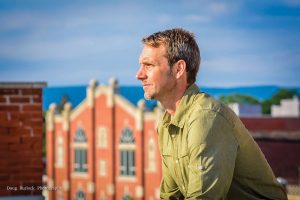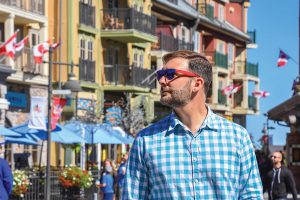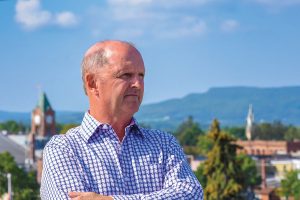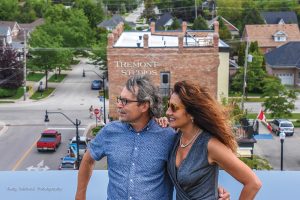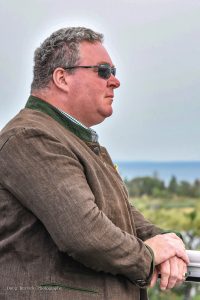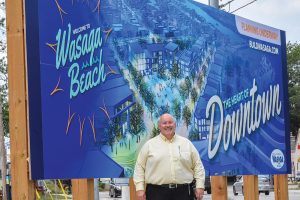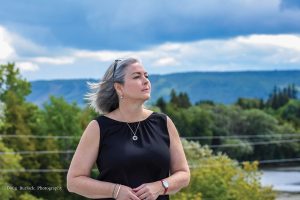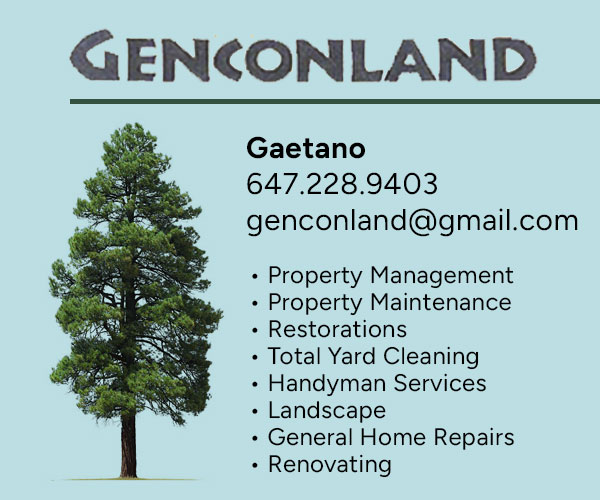What makes Southern Georgian Bay distinct and what does the future hold for the rapidly evolving region we call home? An exploration of the challenges and opportunities we face, told through the lens of 10 local visionaries.
by Janet Lees
photography by Doug Burlock
What makes Southern Georgian Bay distinct and what does the future hold for the rapidly evolving region we call home? An exploration of the challenges and opportunities we face, told through the lens of 10 local visionaries.
Retirees and birdwatching. That was the destiny economist and author David Foot envisioned for our region when I interviewed him 14 years ago for an article in the inaugural issue of On The Bay. Foot had foretold the growth of our region in his seminal 1996 book, Boom, Bust & Echo, concluding that as our country’s 10 million baby boomers aged, they would be looking for semi-rural areas such as ours in which to spend their golden years.
These well-educated, affluent boomers, he predicted, would make a positive contribution to our community by supporting cultural and charitable causes. And as they aged, they would turn to ever-more-passive recreational pursuits, gravitating from skiing, tennis and hockey to golf, birdwatching and gardening.
“It’s no longer just people coming up here to retire; we have young families and young adults coming here because it is a lifestyle choice that they’re making.”
Martin Rydlo
Foot was right about a lot of things, but he was only partially right about others. And he couldn’t have been more wrong about birdwatching.
here Foot’s vision faltered was in failing to recognize that the baby boom generation is unlike any demographic cohort that came before it, remaining active, engaged and energetic well beyond the age when previous generations started creaking towards the rocking chair. As the boomers age, they are not slowing down, and those who are heading for our region are more likely to be seen playing competitive tennis, competing in triathlons or cycling in a Centurion race than standing in a field with a pair of binoculars trained skyward.
As Foot foresaw, Southern Georgian Bay has become one of the fastest growing regions in Canada, due in part to his predicted influx of baby boomers in their 50s, 60s and 70s, but also attributable to an increasing migration of those in their 30s and 40s who, attracted by our region’s natural amenities and active lifestyle, are finding new, innovative and entrepreneurial ways to live, work and raise their families here.
With growth come challenges as well as opportunities, and it will be up to us to ensure that our region maintains its charms while accommodating the demands of a larger, more diverse population. To find out what the future holds, we interviewed 10 visionaries from a diverse range of backgrounds, sectors and areas of influence to gain an understanding of the prospects for Southern Georgian Bay and how today’s decisions will shape tomorrow’s reality.
“Collingwood is at a tipping point,” says Martin Rydlo, fairly buzzing with enthusiasm as he describes the economic and demographic shifts that are driving double-digit growth over the past three years in the number of small businesses looking to set up shop locally.
As the town’s marketing and business development director, Rydlo oversees the Business Development Centre (BDC), a collaborative project between the Town of Collingwood, the Downtown Collingwood Business Improvement Area, the provincially funded Small Business Enterprise Centre, and the federally funded Centre for Business and Economic Development. These BDC partners offer guidance, mentorship, start-up information, registration assistance, loans and other resources to support new and expanding local businesses.
“I thrive off the energy of the people I see coming in here,” says Rydlo. “In terms of the Small Business Enterprise Centre, they’re at 40 to 50 per cent growth in terms of the number of people wanting to book meetings, which is dramatically different than three years ago, and over 50 per cent of those meetings are then resulting in meetings with other partners in the Business Development Centre. These are people who are choosing to move here, to set up their companies here, to grow their companies here because of the lifestyle.”
This influx of small, entrepreneurial businesses has been so pronounced, Collingwood has landed on several prominent lists of the top entrepreneurial communities in Canada since 2015.
With our four-season, active lifestyle drawing entrepreneurs and young professionals as well as retirees to the area, our demographics are becoming more multi-generational, says Rydlo.
“The population growth we’re seeing is definitely changing. It’s no longer just people coming up here to retire; we have young families and young adults coming here because it is a lifestyle choice that they’re making,” he notes, adding, “Even for retirees, who used to come here for economic reasons because it was cheaper to retire here than in Toronto, now what I’m hearing is that people are retiring here because they want to continue an active lifestyle and because it’s a place where their families want to come for weekends and holidays, or even better, they want to live here.”
This focus on lifestyle is in turn driving a new and burgeoning shift in the local economy. “We’ve seen an acceleration from an industrial economy to a tourism economy and now it’s tipping over into a healthy lifestyle economy not unlike Ashland, Oregon or Boulder, Colorado,” says Rydlo. “They went through the same tipping point analogy that we’re going through now, and we’re already seeing that 30 per cent of jobs in Collingwood are somehow related to the healthcare sector; that’s number two after tourism at 37 per cent.”
Healthy lifestyle entrepreneurship is just one of several “areas of excellence” to focus Collingwood’s economic development efforts. Others include tourism innovation, environmental innovation, knowledge innovation and food-and-beverage innovation.
As an example of the latter, Rydlo cites the three craft breweries currently operating in Collingwood. “When they started off they collectively employed about 25 people; I’m estimating they are probably just shy of 200 people they are employing now,” he says. “They’re a huge tourism attractor and a huge economic driver because they’re employing people, but they’re also making other companies notice these companies that are hallmarks of innovation setting up here, and those business owners are saying, ‘that’s what I want to offer my employees and how I want to fuel my company.’”
Rydlo’s vision extends beyond Collingwood, and he is working closely with other local municipalities, counties and groups to ensure that the entire region benefits from shared opportunities. With Southern Georgian Bay spanning two counties and comprising a multitude of municipalities, Rydlo sees collaboration as the key to continuing the forward momentum.
“If we don’t continue to collaborate and we don’t continue to grasp opportunities that are presented to us and we don’t think creatively in terms of perhaps adjusting how we secure resources to go after these opportunities … we’re going to lose the momentum that we have worked so hard to develop as a community and as a region over the last three or four years to realize the vision that has been in the works for the last 10 or 20 years.”
“We are over-indexed in beautiful estate developments and we are under-indexed in higher density, attainable housing and housing product for the emerging business leader or someone who is early in their career.”
Andrew Siegwart
One of the best current examples of collaboration is the South Georgian Bay Regional Labour Supply Task Force, which includes representatives from Simcoe and Grey counties, Meaford, Collingwood, The Blue Mountains, Wasaga Beach, Georgian College, local labour boards and area tourism organizations.
Andrew Siegwart, chair of the Blue Mountain Village Association, formed the task force in early 2017 to address what he and other community leaders see as an ongoing and widespread labour shortage that has reached crisis proportions.
“One of our most critical issues – I’m going to call it a crisis – is labour supply,” says Siegwart. “When we were looking at the winter season last year, I did a quick survey of all of our stakeholders just in the Village alone and we were minimally 150 employees short. When you extrapolate that across the region, my estimates were that we were about 700 people short starting our busiest season last year. When summer came around we had similar shortages.”
In speaking to merchants and business operators throughout Southern Georgian Bay, Siegwart hears a common refrain over and over again. “The statement I hear most often, and it stops me in my tracks, is, ‘We would be doing more business if we had more people. I have unfilled capacity and unmet demand.’ So from a growth perspective it is a huge, huge risk for us,” says Siegwart.
“Part of why people are coming here is because they know they’re going to get exceptional service, they’re going to get that great restaurant experience, they’re going to get to shop in some amazing stores and galleries, they’re going to get to experience the Village or the downtowns. That experience is compromised if you can’t recruit people.” He points to two main reasons for the ongoing labour shortage: lack of workforce housing and limited transportation options.
“The real estate strategy this region has followed is very homogenous and needs to be much more diverse,” he notes. “We are over-indexed in beautiful estate developments and we are under-indexed in higher density, attainable housing and housing product for the emerging business leader or someone who is early in their career.”
A more diverse range of housing options is needed, says Siegwart, including more rental units, apartments, townhomes and lower-cost housing.
“The Town of Blue Mountains alone, in its official plan, really does not factor in any workforce housing or strategy. And to be fair, when the Village was first built out 20 years ago, it was a different world, and I don’t think those plans contemplated where we would be today. Our success has been such that it just wasn’t contemplated.”
On the transit side, Wasaga Beach, Collingwood and Blue Mountain are connected through public transit; however, Thornbury, Meaford and other areas of the region are without any form of public transportation, and the only public transit link between Meaford and Collingwood is a Greyhound route that travels in each direction only once a day. So someone who works at Blue Mountain and can only find affordable housing in Meaford would be unable to get to and from work without a car. And owning a vehicle may not be a viable or attractive option for millennials, those just beginning their careers or those who are accustomed to public transit in larger centres.
“Attainable housing and transit connectivity are intrinsically linked,” explains Siegwart. “We need to take the next step strategically, and that’s going to take leadership and will. We need to invest in the infrastructure that will take us where we need to go.”
Part of the challenge, he adds, is the perception that those who would benefit from affordable housing and transit are “merely” minimum-wage or part-time workers, whereas the reality is that our region’s workforce includes entry-level professionals, tradespeople, landscapers, artists and others who work full time and earn more than minimum wage but are not in a position yet in their careers to be able to afford to purchase a home or vehicle.
As our region’s largest industry and its largest employment sector, tourism doesn’t get the respect it deserves, says Siegwart. “Across the region, tourism employs thousands of people, and we need to become tourism proud. We need to embrace the role that tourism plays in our economy and our community, and we need our counties and municipalities to believe in and support the tourism sector.”
“It should be coordinated by a regional government and a regional planning authority looking at the entire region, understanding who we are and acting accordingly.”
Larry Dunn
Larry Dunn is one local business leader who has embraced the connection between tourism and transportation. The developer behind the Georgian Bay Club and Lora Bay, Dunn is currently building two new hotels in Collingwood. And in a visionary move, he also purchased Ace Cabs four years ago and recently purchased Summerbound/Snowbound, which operates bus tours and a limousine service as well as boat tours and charters on and around Southern Georgian Bay.
“I saw it as an extension of what we’re building,” he says of the rationale behind the move into the transportation sector, adding, “We will continue to expand the transportation side of our business.”
People who come to the area’s growing number of hotels and resorts need to get around to the downtowns, the golf courses, the Village at Blue, the restaurants and entertainment venues, so the demand for public transportation will continue to increase over the coming years, he predicts. “Transportation will be a huge part of what happens in our area,” says Dunn. “Eventually you won’t get a parking spot at the Village; you will be put on a shuttle and transported there. It’s just not efficient the way it’s being handled today.
“I also believe some day we will get a casino and I will support that if it’s done properly, if a boutique casino is included in a destination resort that also includes hotels and entertainment. It would be wonderful for the community and it’s going to produce a lot of high-paying jobs, but there’s a big transportation component within that.”
Currently, a shuttle bus runs between Wasaga Beach and Collingwood and another between Collingwood and the Village at Blue, but there is no public transit connecting Thornbury or Meaford with Blue Mountain or Collingwood.
However, Dunn sees the lack of co-ordinated, region-wide transportation as just a symptom of a larger issue: the need for a regional government in Southern Georgian Bay that would connect the two counties and multiple municipalities under one regional planning authority.
“Right now when you take a look at what’s happening in each of these communities, they’re all doing strategic plans, waterfront plans and the like, and it’s reactive; they put their individual plans together and then they look to the other communities for support,” he notes. “They’re all trying to understand who they are, and it should be coordinated by a regional government and a regional planning authority looking at the entire region, understanding who we are and acting accordingly.”
One example of where a regional approach and collaboration is needed, he says, is the Collingwood Airport, which is located in Clearview Township but is run by the Town of Collingwood. “If, in fact, we were one community, I think the airport would be a whole lot more successful and I truly believe we need to see it become more successful.”
Continued growth is inevitable as more people migrate here for the lifestyle, says Dunn, and there will be pressure on our leaders to manage that growth in an achievable, sustainable and affordable way while providing for the needs of a larger and more diverse population, including housing options, transportation, healthcare, education, recreation and culture.
“Growth is good, but it has to be the right growth,” he maintains. “Everyone wants to be the last person that moves here, but if our region had stopped growing 10 years ago we would be in big trouble. Leadership will be key for this region and I think it is one of the most important components as we move forward. We need leaders who are focused on what’s right as opposed to who’s right; people who are great listeners and can build consensus.”
“By investing in people, particularly the next generation, and providing support for them to take on more leadership roles, we can fulfill the full potential of our region through the years to come.”
Rosalyn Morrison
Like many transplants from the city, Rosalyn Morrison brings a wealth of leadership experience to our region. A senior advisor to the Toronto Foundation who has held several executive roles in the arts and culture sector, she now sits on the board of the Institute of Southern Georgian Bay, a regional nonprofit “think and do tank.”
The “do” part is critical, says Morrison, because even the best ideas are useless if they’re not acted upon. “The roadblock is that we can think and we can talk,” she says, “but we also must recognize the challenges of bandwidth for the people and organizations in the trenches, and the fact that we are not well enough connected yet with our groups of people and our different sectors.”
Whether we’re weekenders, part-timers or full-time residents, we have all chosen to be here because of shared activities and common interests, says Morrison, adding, “We need to build on that common ground and common understanding to create bonds and find ways to overcome the ‘us’ versus ‘them’ attitude that threatens to divide our communities. We’re all in this together, and we need to be thinking about us all as one, and looking at how we build better connectivity between all the people who love this place.”
While economic development and physical infrastructure such as housing and transportation are important, community building also requires a solid “social infrastructure” with triple bottom lines (financial, social and environmental), says Morrison.
“It is a culture shift; it’s a mindset shift to ensure that every decision we make has that triple bottom line: it’s good for people first, good for the economy second, and then third, it has to be good for the environment because that’s why we love this place,” she explains. “It takes more time up front, but it’s going to give us greater impact in the long run.”
Her vision for our future includes both social and economic prosperity, greater civic engagement and philanthrophy, more emphasis on developing our youth and investing in their futures, as well as a senior care strategy that will ensure healthcare, housing and support as our population ages. One way to get there would be to develop “community innovation hubs” that focus on specific areas such as health, housing, youth, the environment, agriculture and food security.
Those groups could then come together to help create a community action plan, she says.
“Many jurisdictions are creating community action plans because they understand that you have to have the integration of the community organizations working on the ground, in the trenches, figuring out how to create more bandwidth, how you can bring them together to see the possibilities of collaboration, how you can bring philanthropists and businesses into the mix, to make sure that whatever is happening at a policy level from government is being leveraged, or it could be that these conversations catalyze new ideas and new potential policies.”
Morrison sees engaging and providing leadership opportunities for youth and those in their 20s, 30s and 40s as the key to our region’s future.
“By investing in people, particularly the next generation, and providing support for them to take on more leadership roles, we can fulfill the full potential of our region through the years to come.”
“I’d like Meaford to keep its heart and the simplicity I fell in love with, but just on a grander scale. I wouldn’t want it to lose its integrity or become overrun with tourists, but just to be a little shinier and more vibrant.”
Nadia Mear
Nadia Mear, one of the under-40 crowd who is getting involved in her community of Meaford, agrees that the younger set has much to offer.
“I’m seeing a resurgence of youth in the community who are wanting to stay here and wanting to see it grow and succeed,” says Mear. “There are a lot of young people – and by young I mean under 50 – who are living here by choice and who want more involvement in the community. They want more of a say and more of an impact in the municipality. They want to see Meaford blossom into the community we know it’s capable of becoming.”
Mear, a performing artist, sees the arts as one sector where younger people can engage, and Meaford as the new frontier for our region’s flourishing arts and culture community. To that end, since moving to the area from
Vancouver in 2014, she co-founded Theatre Georgian Bay, which performs at the Collingwood Shipyards Amphitheatre as well as the Meaford Hall Arts and Cultural Centre. She also runs performing arts classes for kids and teens through Meaford’s Sandcastle Theatre, and she and her husband, an artist, have started a local artists’ coop called the Meaford Artisan’s Hub.
“I believe that if you build it they will come; if you create art and venues for artists then there is a reason for people to come to the town, which benefits businesses, restaurants and tourism,” says Mear. “Our goal is to become part of that trend, and I do see Meaford becoming on par with Clarksburg and Simcoe Street in terms of what we could be artistically and culturally.”
Meaford is already attracting home buyers with its lower housing prices, and there is a proposal in the works for a revamped downtown with destination-style shops and galleries as well as apartments for walkable living. Mear says the town’s hidden gem of a waterfront could also be more of a draw with outdoor performing and visual arts events.
She adds this vision is scalable and can be achieved without sacrificing Meaford’s rural, small-town character. “I’d like Meaford to keep its heart and the simplicity I fell in love with, but just on a grander scale,” she says. “I wouldn’t want it to lose its integrity or become overrun with tourists, but just to be a little shinier and more vibrant. I’d like to see people struggle less financially. In my experience a lot of people work a job so that they can also do their art; it would be nice for those people to also make some money so they can do their art and also live their lives.
“We’re right on the brink of something cool. I’m looking forward to the crossroads – that magical point where everyone comes together with a common appreciation for our community and what it can be.”
“It’s all about placemaking: finding those little squares and areas where you can create interesting places that people can discover and explore as part of a larger downtown.”
Richard & Anke Lex
Richard and Anke Lex have proven that arts and culture can indeed have a huge impact on community building: their revitalization of Collingwood’s Simcoe Street as an artsy enclave of galleries, theatres, cafés and events is a model for turning vision into reality while maintaining the small-town feel.
It all started with the former Tremont Hotel, a dilapidated and downright ugly building that was slated for demolition. Where some saw old and useless, the Lexes saw potential, purchased the historic building and embarked on a restoration that was nothing short of transformational. Today the Tremont houses a gallery, a restaurant and artists’ studios.
“When people come here and buy a piece of art, they’re not just buying a product,” says Anke. “They’re meeting the person who made the art, they’re making a connection with the artist, and they’re buying it in this building that has been part of our community for over 100 years.”
For the Lexes, culture is inextricably linked to heritage, and Richard in particular has been instrumental in protecting and restoring downtown Collingwood’s historic buildings through the Architectural Conservancy of Ontario and the town’s heritage committee.
“If you look at the changes that have come, the improvements downtown and how the heritage guidelines have guided those improvements, renovations and restorations downtown, it would be wonderful to see that continue,” says Richard. “We’ve seen a lot of gentrification, but hopefully as we move into the future we don’t gentrify to the point where we lose the authenticity that we have in the downtown.”
His vision includes expanding Downtown Collingwood even further to connect with the waterfront and the trails, and creating more pockets in the downtown proper for people to explore. “We still need to develop the side streets, the back lanes, the alleyways,” he says. “It’s all about placemaking: finding those little squares and areas where you can create interesting places that people can discover and explore as part of a larger downtown.”
Adds Anke, “We have a fantastic foundation; we just need to recognize it and keep building on it.”
The Lexes see small, independent, one-of-a-kind businesses as the key to Downtown Collingwood’s success both now and in the future. They also envision a further expansion of the cultural scene in Collingwood to include even more arts, theatre, live music and events.
“Studies show that arts and culture tourists tend to spend the most money in a community,” says Anke. “They go out for dinners to independent restaurants, they shop at independent retailers, they spend more time in the town.”
But it’s not just tourists whose interest in cultural activities bring benefits to the town; many of the plays, shows and concerts at the Lexes’ Simcoe Street Theatre, for example, draw a diverse crowd made up of both locals and out-of-towners.
“Creating a hub for arts and culture attracts young, exciting, sophisticated people who want opportunities for night life and entertainment, who want to be part of a community, and we’re seeing more and more of those young people spending more time here and settling here because of that connection,” says Richard.
“In the same way people came up here to ski 40 years ago, now the next generations are being drawn professionally as well as recreationally.”
Desmond Von Teichman
As the owner of the region’s largest real estate company, Desmond Von Teichman has seen Southern Georgian Bay evolve from a winter playground and retirement mecca to a four-season active lifestyle community with an increasingly more diverse population.
“In the same way people came up here to ski 40 years ago, now the next generations are being drawn professionally as well as recreationally,” he says. “It’s not just people at the end of their work or life cycle; it’s becoming much more inclusive. We have a range of people, some of whom are retired or semi-retired as well as others who are working, telecommuting, consulting, starting businesses, and they’re also skiing, riding horses, cycling, playing tennis and pickleball and all the other great things they can do here.
“There’s an enormous component of people who are young, vibrant and interested in the culture and the culinary aspect and the lifestyle, but they’re also incredibly community minded without placing restrictions on who else comes here.”
That diversity and inclusivity bodes well for the region’s future, he says, but only if leaders and community members embrace change and “smart growth,” which values long-range, sustainable development over a short-term focus, with the goals of achieving a unique sense of community and place; expanding the range of transportation, employment, and housing choices; equitably distributing the costs and benefits of development; preserving and enhancing natural and cultural resources; and promoting public health.
“You can augment those amenities without bastardizing them, and you can have growth without paving paradise,” says Von Teichman, adding, “There are some who stand in the way of what I would consider to be progress based on their unwillingness to see what they bought into change even vaguely. It’s destructive, and it’s the one thing that will undermine our success if we let it.
“I love that people love this place so much that they want to be part of it, but it’s not fair to close the gates when we have so much to offer here.”
He sees Meaford as our region’s next major growth area, due to lower real estate prices and abundant natural amenities. “I think Meaford is one of the great real estate opportunities around right now, and I’ve been saying for 10 years that I don’t understand the disparity in price between Meaford and Town of Blue Mountains,” he notes. “They’re 11 kilometres apart, but Meaford has been between a half and a third of the prices in Town of Blue Mountains for years. Meaford has all the access to trails and skiing and hiking and biking and golfing, and it has what a whole bunch of areas around us don’t have, which is affordability.”
That affordability could change, however, if smart development is hindered in Meaford due to an “insular mentality,” says Von Teichman.
“It’s supply and demand,” he explains. “The demand is there whether you like it or not, so by preventing the building of smart new development, you inadvertently drive prices up, which makes everything less attainable.”
Our region has been built by visionaries, says Von Teichman, from Jozo Weider turning Blue Mountain into a ski resort, to those who championed turning the old CN rail line into the Georgian Trail, to the many entrepreneurs and restaurateurs who have built businesses here. All signs point to that trend continuing, he says. “It’s going to be an interesting few years. We have two distinct markets: the retirees who are coming here to actively retire, and the separate market of the 30-somethings, 40-somethings and 50-somethings who are still actively working but don’t require being in the city to be successful.
“The natural elements of this place brought people here, but now those people are bringing other people. It’s not a sell anymore, it’s a buy. People want to be here; they don’t have to be convinced to come. I think we’re destined to be an exciting, vibrant, entrepreneurial, active and community minded region.”
“The opportunities in Wasaga Beach, in my opinion, are endless,” says Smith. “We have a clean canvas to start fresh; most communities would welcome that opportunityand we are embracing it wholeheartedly.”
Brian Smith
Wasaga Beach Mayor Brian Smith couldn’t agree more, and he’s put his town’s money where his mouth is. Council took an audacious leap in 2015, voting to buy seven Beach Area One properties that were destroyed by fire, at a cost of $13.8 million. Now, as the owner of 76 per cent of the land at the main beach area and with a new Master Plan approved at the end of March, Wasaga Beach is poised to begin rebuilding its downtown and waterfront.
The town recently named Fram-Slokker, the developer of the Shipyards in Collingwood, as the building partner for the project, and is currently conducting an audit to ensure Fram-Slokker can meet the financial obligation. The plan calls for a pedestrian-friendly mix of business and residential units as well as a town square and “entertainment zones” that could include water parks, rides and amusements, arcades and performance venues.
“The opportunities in Wasaga Beach, in my opinion, are endless,” says Smith. “We have a clean canvas to start fresh; most communities would welcome that opportunity and we are embracing it wholeheartedly.”
With the longest freshwater beach in the world, returning to its heyday as a summer destination is perhaps not a stretch. The greater challenge, says Smith, will be to create a main street and beachfront that will attract tourists in all seasons regardless of the weather.
“We have no doubt that Wasaga Beach will once again be one of the premier destinations for the summer,” says Smith. “We also know that at one time Wasaga Beach was the snowmobile capital of Ontario, and we know that our cross-country ski trails today are some of the best out there.”
He also takes a regional approach, looking at the activities and attractions other area communities offer in order to draw people to nearby Wasaga Beach.
“Blue Mountain is 30 minutes away; Horseshoe Valley is 25 minutes away and we need to capitalize on that,” says Smith. “But we know that people aren’t going to stay in Wasaga Beach in the winter or if it’s raining if we don’t have hotels and accommodation, if we don’t have perhaps an indoor water park and a bowling alley, if we don’t have great restaurants and shops.”
But tourists aren’t the only ones who will benefit; local residents will finally have a real downtown as well as community gathering places, amenities and entertainment venues – a “complete community,” in Smith’s eyes. It’s a bold plan, and one that not all residents or councillors endorse. But Smith and his supporters are undaunted by the naysayers.
“We’re only going to get there if we have vision, if we have a dream, and if we’re not afraid to fail,” he declares. “What we know for sure is this: if we don’t try, if we don’t strive for better, we’re never going to get there. Doing nothing is an absolute sound plan for doomsday.”
The challenge, he says, is to create an identity that appeals to all ages and all demographics, while building a community that is a source of pride for those who choose to live there.
“Our greatest strength is our people,” Smith enthuses. “Our citizens are engaged, whether or not they agree with us; they’re extremely generous of their time and their wallet, and they’re passionate. I think the vast majority want affordable, sustainable, positive change and we need to be welcoming, open minded, inclusive, and to realize that anything great in this world has happened because it started with an idea.”
“We know that growth is imminent to our community, and we have an opportunity to decide who we are, what kind of community we want to be and what kind of people we want to attract to our community.”
Thom Paterson
Whereas Wasaga Beach is pursuing development wholeheartedly, Clearview Township is more ambivalent about growth, says Thom Paterson, who has been a Clearview councillor since 2006.
“Unlike Wasaga Beach and Collingwood, which have experienced some very good growth, Clearview hasn’t had much growth,” says Paterson, noting that the 2016 census actually showed a one per cent decline in Clearview’s population. “However, we know that growth is imminent to our community, and we have an opportunity to decide who we are, what kind of community we want to be and what kind of people we want to attract to our community.”
More than 20 residential development projects are currently on the books in Clearview, with developers looking to build close to 5,000 homes throughout the township over the next several years. Many of the developments are aimed at first-time homebuyers as well as retirees looking to downsize – two groups that have typically been under-served in an area replete with larger homes on large properties.
Since Clearview amalgamated in 1994, it has been difficult to create a cohesive identity among the collection of rural communities that make up the township, says Paterson.
“Clearview has an identity crisis. There’s still an angst between all of us in terms of who we are and where we’re going. People know Creemore because of the beer, but if you ask somebody where Clearview is, they don’t know, and very few people identify themselves as living in Clearview Township; they identify with their community, whether it be Stayner, Creemore, New Lowell, Singhampton or Duntroon.
“We have a strong identity and pride in where we live, so do we take advantage of that and become a community of communities, something unique in Ontario? Or do we just label everything Clearview Township? That’s the tension we have.”
Unlike the rest of Southern Georgian Bay, Clearview doesn’t bring in large numbers of tourists; instead, the local economy still depends heavily on agriculture. Even with no concerted effort to draw agriculture-related businesses to the area, a state-of-the-art medical marijuana facility and a number of organic farms have chosen to locate in Clearview. Agriculture today is a sophisticated business, says Paterson, and should be a focus of the township’s economic development efforts.
On the regional level, Paterson echoes Larry Dunn in predicting that regional government will be debated, possibly even becoming a talking point in future elections. He is less sure that region-wide amalgamation will actually come to fruition in the next decade, but he sees more regional cooperation as a positive step forward.
A proposed industrial development near Collingwood Airport is a perfect opportunity for regional collaboration and success, he notes.
“The airport is a great regional asset and a de facto regional effort. The land is in Clearview, it’s owned by Collingwood, the opportunities are coming to us from externally, and the benefits are shared by Wasaga Beach, The Blue Mountains and surrounding communities. I think Clearview is positioning itself as a good regional partner because we sense we’re going to play a larger role as a municipality in the region.”
Another example of a regional exercise that will benefit all of us is the new hospital, says Paterson, who is chair of the Collingwood General & Marine Hospital’s board of trustees. In stage one of five stages, the hospital board has provided its vision for clinical services and programs to the provincial Ministry of Health, along with three options for the site of the new hospital: the existing location expanded, a greenfield site on Poplar Sideroad in Collingwood, or a greenfield site in Wasaga Beach.
The hospital board has named the Poplar site as its preferred location, and the councils of Wasaga Beach, Clearview, The Blue Mountains and Grey Highlands have supported that option. Collingwood Council has so far deferred its decision on a preferred site.
“All of the municipalities support a new hospital,” says Paterson. “There are still some decisions to be made in terms of final siting and we’re hoping those can be made at stage two. But it’s a good example of a true regional effort because we see ourselves as a regional hospital and we have built a model for a hospital that will take care of our population – both the aging and the young – into the future, no matter which site the ministry approves.”
“Weekenders and people who have second homes here want the same quality they can get in the city, and businesses here cater to people’s needs.”
Casey Thomson
Unlike Clearview, Thornbury has had no trouble defining itself. “Thornbury today is a boutique town made up almost exclusively of small, independent businesses that are attracting four-season visitors and residents who are active, outgoing and like the finer things in life,” says Casey Thomson, a Thornbury business owner who also serves as chair of the economic development advisory committee for the Town of Blue Mountains and vice chair of the Thornbury Business Improvement Area.
“It’s a four-season destination, it’s charming, it has an old style main street with high-end stores, it has amazing restaurants with top-level chefs, it has an agricultural history and a continuing focus on local foods. Weekenders and people who have second homes here want the same quality they can get in the city, and businesses here cater to people’s needs.”
After the development of Blue Mountain Village, Thornbury initially saw a drop in visitors as tourists had more reasons to stay at the Village, but now that evolution is coming full circle, says Thomson.
“Today Thornbury is much more integrated with the Village,” she notes. “Absolutely the Village draws tourists; however, locals and weekenders don’t always want to go to the Village, so they’ll come to Thornbury. And the Village is working very hard to push those tourists out of the Village to give them more variety of experiences so they’ll want to come back because there’s so much to do and see across our region.”
Thornbury is also experiencing many of the challenges faced by Blue Mountain Village, including a lack of housing for the growing population of working people and lack of transit between communities. The increase in young families moving to the area has also resulted in a day care shortage, Thomson adds.
“We’re experiencing a crisis in day care,” says Thomson. “We have 75 people on a waiting list for day care in Thornbury alone. We’re in the process of looking into it to see if it’s an issue of affordability or availability. My gut says it’s availability because even if people can afford it, we don’t have it, and we don’t have it because the people who would work in the day cares can’t afford to live here and they don’t have transit. So it’s all interconnected.”
Thornbury’s population has nearly doubled over the past 10 years, and some projections are that will double again in the next 10 years to between 12,000 and 13,000 full-time residents.
“For that to happen, we need to have all pillars within our community,” says Thomson. “If we double in size in the next 10 years and we don’t have transit or housing or day care, our labour market will be in a full-blown crisis and I don’t even know how we’ll recover from that.”
Thornbury is at heart an entrepreneurial community, says Thomson, who has seen her own business, The Cheese Gallery, more than double since 2010. “It is very, very exciting what is happening around the whole entrepreneurial, culinary, agricultural, tourism piece,” she says. “It’s going to explode even more, and we are going to see more craft breweries, more wineries, more cideries, more food-related businesses, more restaurants, not just for Thornbury but for the entire region.”
The growth is coming whether we like it or not, says Thomson, and it will be up to our community leaders to figure out how to manage what is on the horizon while still keeping what she calls the “small townisms” – the small-town flavour, connectivity and support.
“I hope in 10 years we still have those small townisms and that this continues to be a place you love to call home. I hope it continues to be a full and vibrant community of all ages, because that is what makes a healthy community. In a small town where you have small townisms, you love each other, you support each other, and you all grow together.”
In short, the vision Southern Georgian Bay’s future is diverse, inclusive, entrepreneurial, innovative, philanthropic, collaborative and community minded, with thoughtful and well-planned development, a variety of housing options, first-rate healthcare, more public transit links between communities, a larger labour force, a booming business community and a thriving arts and cultural component.
These and many other visionaries are building a new dawn for Southern Georgian Bay, working with imagination, insight and boldness to call forth the best in our people and bring them together around a shared sense of purpose. As our region grows and evolves, we will need innovators and change agents who can see the big picture, think strategically and take well-considered action toward common goals. True visionary leaders serve the good of the whole, taking a broad view as opposed to merely serving narrow interests. Their eyes are on the horizon, and we are all invited to share the journey.
“We do have the power to determine our destiny,” affirms Rosalyn Morrison. “It’s about finding the balance between enjoying the beauty of this place we call Southern Georgian Bay and getting much more civically engaged in shaping our collective future.” ❧
Have Your Say! Do you agree with these visionaries? What is your vision for our region’s future? What do you see as the challenges and opportunities we face? Let’s keep the discussion going! Send a letter to the editor by emailing readermail@onthebaymagazine.com or go to www.onthebaymagazine.com and click “Have Your Say.” Letters will be published in an upcoming issue of On The Bay.







